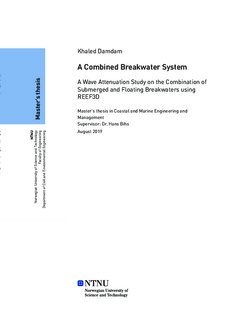| dc.description.abstract | Coastal zones have been a dynamic area and most favoured locations utilized for
living, leisure, recreational activities, tourism, commerce and many other human ac-
activities. Submerged and floating breakwaters have been used as effective systems to
protect these zones from wave attack. However, they are only effectively functional
if the incident wave height is relatively low. Under such condition, these systems can
reduce the wave transmission with significant wave dissipation and hence achieving
a desirable tranquillity in designated areas. Therefore, the focus of this research is
mainly to investigate the possibility of using a combination of a submerged porous
breakwater (SBW) with a floating breakwater (FBW) as an innovative coastal protection system that can provide adequate calm conditions in the coastal zones with
minimum visual impact. This study utilizes the open-source CFD model, REEF3D
to simulate such wave-structure interaction. This CFD model is based on the RANS
equations coupled with the level set method and the k − ω turbulence model
In the present study, the first section deals with the simulation of irregular wave
breaking over an irregular bed profile with the use of wave reconstruction method
to generate irregular waves. An excellent agreement between the computed results
and the experimental data is obtained showing that REEF3D model is capable of
capturing the dominant features of the evolution of the wave breaking process, both
in the shoaling region and the surf zone.
The second section deals with the simulation of regular wave interaction with the
SBW. The simulation is conducted using the VRANS method to resolve the porous
flow. The wave interaction with the SBW is validated by comparison with experimental data. An impressive agreement between the numerical results and the experimental data is achieved with very small RMSE values. Finally, the validated
model is then used to simulate the combination of the SBW and the FBW. Three
different cases are investigated with three different spacing between these structures.
For each case, five different configurations related to the geometry of the FBW are
simulated. It is found out that an effective reduction of more than 90%, on average,
of the incident wave height, can be achieved for this combined breakwaters system. This means that a transmission coefficient (Kt ) of less than 10% is calculated across
this combination. Besides, it is found out that 1.75 FBW length to wavelength (L/λ)
ratio produces a very low transmission coefficient (Kt ). Further, an effective distance
of 1-2 wavelength between the SBW and the FBW subsystems can also result in
lower transmission coefficients (Kt ). | |
